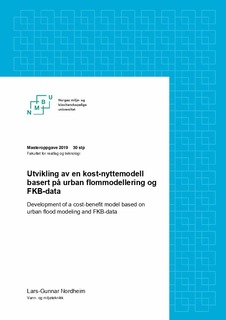| dc.contributor.advisor | Nilsen, Vegard | |
| dc.contributor.advisor | Friborg, Torbjørn | |
| dc.contributor.author | Nordheim, Lars-Gunnar | |
| dc.coverage.spatial | Norway, Akershus, Bærum | nb_NO |
| dc.date.accessioned | 2019-07-19T12:42:57Z | |
| dc.date.available | 2019-07-19T12:42:57Z | |
| dc.date.issued | 2019 | |
| dc.identifier.uri | http://hdl.handle.net/11250/2606004 | |
| dc.description.abstract | Skadelige nedbørshendelser i urbane områder har de siste årene fått økt oppmerksomhet. Bare de siste ti årene har nedbørhendelser i Eiker, Asker og Bærum gitt skader på over 400 millioner kroner. Situasjonen er lik i Sverige og Danmark, som også har opplevd ekstreme nedbørhendelser. Det regnes at hyppigheten i nedbørstilfeller også vil øke ytterlige fremover. Som følge av dette har skadelige nedbørhendelser blitt en del av agendaen til beslutningstagere rundt om i landets kommuner. Det tenkes mye nytt rundt løsninger og tiltak for å mitigere skadepotensialet til nedbørhendelser, men det er ofte usikkert hvilke av løsningene som gir beste resultat til rimeligste krone. Denne oppgaven presenterer en kost-nyttemodell, basert på resultater fra flommodellering, som kan hjelpe beslutningstagere å gjøre de riktige og mest lønnsomme valgene av tiltak mot skadelige nedbørhendelser.
Kost-nyttemodellen er bygget på flomresultater fra modellering, samt tilgjengelig kartdata. På denne måten kan flomutsatte hus, veier og lignende automatisk kvantifiseres, slik at en kostnad raskt kan beregnes. I denne oppgaven ble det tatt utgangspunkt i et område i Bærum kommune, hvor Sweco Norge hadde utviklet en flommodell. Ved hjelp av flomresultatene herfra kunne kost-nyttemodellen kalibreres og testes.
Det ble funnet at kost-nyttemodellen klarer å kvantifisere flomutsatte bygninger på en tilfredsstillende måte, samtidig som det må utføres ytterligere arbeid med å inkludere flere kostnadstyper. Dette gjelder spesielt kostnader knyttet til tidstap, som kan være en betydelig andel av totalkostnaden. Først når et mer helhetlig bilde av kostnadene er representert i modellen vil den være fullkommen nok til å kunne brukes i beslutningssammenheng. Arbeidet med oppgaven viste også at en hyppig benyttet antagelse rundt skadekostnaden ved nedbørshendelser må brukes med omhu, da nedbørhendelser viser seg å være svært kompliserte å karakterisere med en enkel parameter. | nb_NO |
| dc.description.abstract | In recent years, harmful precipitation in urban areas have received increased attention. Only in the last ten years, precipitation incidents in Eiker, Asker and Bærum have caused damage of more than NOK 400 million. The situation is similar in Sweden and Denmark, which have also experienced extreme precipitation events. It is considered that the frequency of harmful precipitation will increase further in coming years. As a result, harmful precipitation incidents have become part of the agenda of decision makers around the country’s municipalities. There are ongoing discussions about solutions and measures to mitigate the damage potential of precipitation incidents, but it is often uncertain which of the solutions yield the best results, for the least amount of money spent. This paper presents a cost-benefit model, based on results from flood modeling, that can help decision makers make the correct and most profitable decisions against harmful precipitation events.
The cost-benefit model is based on results from urban flood modeling, as well as available geographic data, with the goal of automatically quantifying flood-exposed houses, roads and the like. By using this data a cost related to the damage caused could quickly be determined. The area of interest in this thesis was situated in Bærum municipality, where Sweco Norway had developed a flood model. The results from said flood model were used to calibrate and test the cost-benefit model.
It was found that the cost-benefit model manages to quantify flood-prone buildings in a satisfactory manner, at the same time further work must be done to include different cost categories. This applies in particular to costs related to time loss, which can be a significant portion of the total cost. Only when a more comprehensive picture of the costs is represented in the model, will it be good enough to be used in real life applications. Finally it was showed that a frequently used assumption about the damage cost of precipitation events must be used with care, as damage caused by precipitation events prove to be very complicated to characterize with a single parameter. | nb_NO |
| dc.language.iso | nob | nb_NO |
| dc.publisher | Norwegian University of Life Sciences, Ås | nb_NO |
| dc.rights | Attribution-NonCommercial-NoDerivatives 4.0 Internasjonal | * |
| dc.rights.uri | http://creativecommons.org/licenses/by-nc-nd/4.0/deed.no | * |
| dc.subject | Overvann | nb_NO |
| dc.subject | Modellering | nb_NO |
| dc.subject | Vann og miljø | nb_NO |
| dc.title | Utvikling av en kost-nyttemodell basert på urban flommodellering og FKB-data | nb_NO |
| dc.title.alternative | Development of a cost-benefit model based on urban flood modeling and FKB-data | nb_NO |
| dc.type | Master thesis | nb_NO |
| dc.description.localcode | M-VM | nb_NO |

